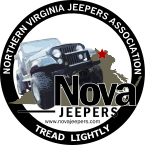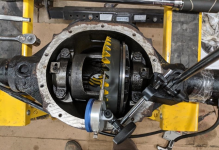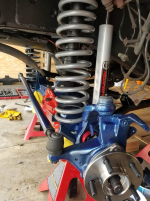Several of you have asked for an origin story of the Wonder Woman Cherokee, so, without further adieu, I give you Lucy (she got her name before her current paint job), the 1997 XJ.
She’s never driven better, and we’re very happy with her current set-up. We still have a few more things in store for her, as always. We started her build in 2018, once I no longer needed her as a daily driver. I had driven her completely stock for 11 years.
We learned many build lessons along the way. Alongside a bit of the process, those lessons are what I hope to share with everyone here. I thought it might be easiest to do this thematically, rather than chronologically, so expect a series of posts going through what we’ve done to the body, suspension, steering, drivetrain (including gears/lockers), wheels/tires, and a few interior mods.
Since the paint job is the most (in)famous, that’s first!
Why did we decide to repaint in the first place?
As with many of the older XJs, the clear coat was flaking in a number of locations, and some rust was growing in the rear quarter panels.
What did we end up using?
We didn’t want to spend a lot of money and we wanted to do the paint ourselves, so the choice to move to bed-liner was a very easy one. After researching a few options, we decided on Monsta-Liner, and we have been very happy with that choice.
Pros:
+ You can roll or spray it on, and they offer complete kits with all you need to do so.
+ The paint is very sticky, so less body prep work is required compared to regular paint. We used 80 grit on a random orbital sander across most of the surface as well as a heavy scuff pad. We only did a deeper sand on the areas where the paint had been flaking.
+ The paint went on in nice, thick coats and has proven to be very durable. It withstands the narrow, brushy sections at Rausch Creek very well!
+ Particularly with the roll-on application (which we did), the paint is not too textured/rough, so dirt is easy to wash off with normal car wash tools/pressure washer.
Cons:
- You can only order in quarts or gallons, you need to calculate beforehand fairly accurately or just end up with some leftover.
- Since it’s a two-part paint, it has a very strong odor. Respirators are definitely needed while working, and you (and your neighbors) will smell it for a couple of days around your house as it cures.
- It appears to have begun to fade a bit, particularly on the roof. We don’t have space for her in the garage, so she’s outside in the sun all the time.
What about the hood?
Obviously, we did something special on the hood and front panels. I wanted to go all-out on the Wonder Woman theme, and Kevin was game. I knew the breastplate design would be extraordinarily difficult to achieve with normal paint masking techniques, so I found a guy on eBay selling vinyl decals of the design I wanted. He was offering them in what I’ll call “normal” sizes. I asked him how big he could make one. He said 2 feet x 4 feet, and I said “Send me one!”
Before applying the decal, we laid down two coats of primer and two coats of gold paint, both from Eastwood. After those cured, we hung a laser level from the rafters in the garage and applied the massive decal to the hood. I extended the stripes down the front quarter panel with masking tape.

I then sprayed around the edges of the decal and tape stripes with a dark silver metallic paint (just a can that came from Advance Auto). As the silver was setting, I pulled up the decal and tape, and voila!

Once the silver cured, we applied a clear coat and allowed to cure again. We then masked the area where the decal had been and began applying the Monsta-liner.

As mentioned above, we rolled the Monsta-Liner - two full coats on both the red and blue sections. Those two coats had to be applied within a certain time of each other for best results per product directions. We did not bother to put Monsta-Liner in the door jambs, as we felt that would take much more effort. Because the vehicle was originally red, it still looks great since there’s no color difference to the interior. Start-to-finish, the entire painting project took about 1.5 weeks.

What lessons did we learn about the paint?
For the second coat of Monsta-liner on the hood, we did not get as much coverage around the breastplate design. This was because we had already pulled up the tape we had used to mask it after the first coat since we were worried it would harden too fast and we wouldn’t get a clean line. However, that meant that we couldn’t go right up to the line on the second coat, particularly because the Monsta-Liner is not very precise and goes on “gloopy.” We subsequently learned that specialized auto masking tape exists with wires embedded in the edge, which is commonly used in commercial bed liner applications. We might have invested in some of that to solve this problem.
We have been less happy with the clear coat on the hood. In our first trip out (about 4 months after applying the clear coat), we got some good Virginia clay/mud on it, which resulted in spots/etching on the surface. We took our truck into the very same mud (with its factory finish), and it did not result in the same issue. We are not sure exactly why this occurred. It could be that the clear itself was not the highest quality. Perhaps we needed to do more coats. Perhaps we should have heated it (we applied in October, approaching the lower range of the satisfactory temperature range for application) – given the heat put off by the 4.0L engine, perhaps we should have just turned it on for a while to help the curing! We now do occasionally polish the area, which makes the spotting less noticeable.
She’s never driven better, and we’re very happy with her current set-up. We still have a few more things in store for her, as always. We started her build in 2018, once I no longer needed her as a daily driver. I had driven her completely stock for 11 years.
We learned many build lessons along the way. Alongside a bit of the process, those lessons are what I hope to share with everyone here. I thought it might be easiest to do this thematically, rather than chronologically, so expect a series of posts going through what we’ve done to the body, suspension, steering, drivetrain (including gears/lockers), wheels/tires, and a few interior mods.
Since the paint job is the most (in)famous, that’s first!
Why did we decide to repaint in the first place?
As with many of the older XJs, the clear coat was flaking in a number of locations, and some rust was growing in the rear quarter panels.
What did we end up using?
We didn’t want to spend a lot of money and we wanted to do the paint ourselves, so the choice to move to bed-liner was a very easy one. After researching a few options, we decided on Monsta-Liner, and we have been very happy with that choice.
Pros:
+ You can roll or spray it on, and they offer complete kits with all you need to do so.
+ The paint is very sticky, so less body prep work is required compared to regular paint. We used 80 grit on a random orbital sander across most of the surface as well as a heavy scuff pad. We only did a deeper sand on the areas where the paint had been flaking.
+ The paint went on in nice, thick coats and has proven to be very durable. It withstands the narrow, brushy sections at Rausch Creek very well!
+ Particularly with the roll-on application (which we did), the paint is not too textured/rough, so dirt is easy to wash off with normal car wash tools/pressure washer.
Cons:
- You can only order in quarts or gallons, you need to calculate beforehand fairly accurately or just end up with some leftover.
- Since it’s a two-part paint, it has a very strong odor. Respirators are definitely needed while working, and you (and your neighbors) will smell it for a couple of days around your house as it cures.
- It appears to have begun to fade a bit, particularly on the roof. We don’t have space for her in the garage, so she’s outside in the sun all the time.
What about the hood?
Obviously, we did something special on the hood and front panels. I wanted to go all-out on the Wonder Woman theme, and Kevin was game. I knew the breastplate design would be extraordinarily difficult to achieve with normal paint masking techniques, so I found a guy on eBay selling vinyl decals of the design I wanted. He was offering them in what I’ll call “normal” sizes. I asked him how big he could make one. He said 2 feet x 4 feet, and I said “Send me one!”
Before applying the decal, we laid down two coats of primer and two coats of gold paint, both from Eastwood. After those cured, we hung a laser level from the rafters in the garage and applied the massive decal to the hood. I extended the stripes down the front quarter panel with masking tape.
I then sprayed around the edges of the decal and tape stripes with a dark silver metallic paint (just a can that came from Advance Auto). As the silver was setting, I pulled up the decal and tape, and voila!
Once the silver cured, we applied a clear coat and allowed to cure again. We then masked the area where the decal had been and began applying the Monsta-liner.
As mentioned above, we rolled the Monsta-Liner - two full coats on both the red and blue sections. Those two coats had to be applied within a certain time of each other for best results per product directions. We did not bother to put Monsta-Liner in the door jambs, as we felt that would take much more effort. Because the vehicle was originally red, it still looks great since there’s no color difference to the interior. Start-to-finish, the entire painting project took about 1.5 weeks.
What lessons did we learn about the paint?
For the second coat of Monsta-liner on the hood, we did not get as much coverage around the breastplate design. This was because we had already pulled up the tape we had used to mask it after the first coat since we were worried it would harden too fast and we wouldn’t get a clean line. However, that meant that we couldn’t go right up to the line on the second coat, particularly because the Monsta-Liner is not very precise and goes on “gloopy.” We subsequently learned that specialized auto masking tape exists with wires embedded in the edge, which is commonly used in commercial bed liner applications. We might have invested in some of that to solve this problem.
We have been less happy with the clear coat on the hood. In our first trip out (about 4 months after applying the clear coat), we got some good Virginia clay/mud on it, which resulted in spots/etching on the surface. We took our truck into the very same mud (with its factory finish), and it did not result in the same issue. We are not sure exactly why this occurred. It could be that the clear itself was not the highest quality. Perhaps we needed to do more coats. Perhaps we should have heated it (we applied in October, approaching the lower range of the satisfactory temperature range for application) – given the heat put off by the 4.0L engine, perhaps we should have just turned it on for a while to help the curing! We now do occasionally polish the area, which makes the spotting less noticeable.






